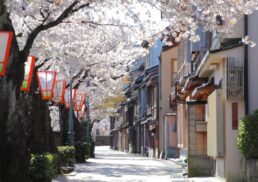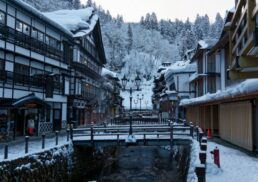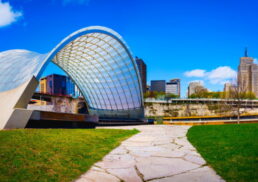Want to improve your outdoor space? This guide on designs of landscaping covers modern farmhouse, traditional, and contemporary styles. Learn practical ideas for plants, patios, and seasonal features to create your dream yard.
Table of Contents
Key Takeaways
Landscape design styles, such as modern farmhouse and contemporary, guide homeowners in selecting aesthetic elements that fit their vision and outdoor conditions.
Effective planting techniques, including the use of native plants and raised beds, enhance both the visual appeal and functionality of landscaping.
Incorporating functional outdoor elements, like seating areas and pathways, maximizes space and improves the overall enjoyment of outdoor environments.
Exploring Landscape Design Styles
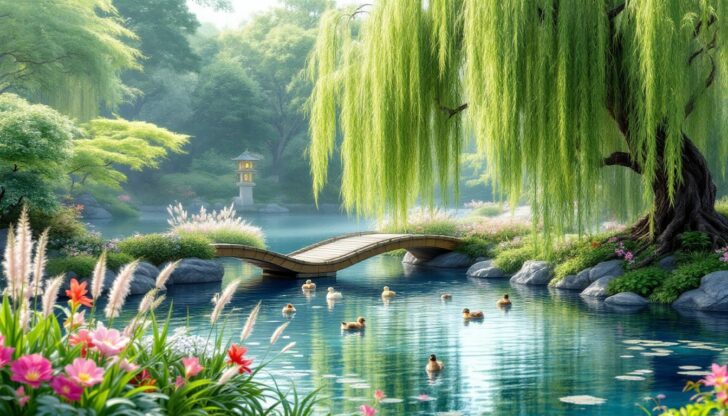
Landscape design styles offer a canvas for creative expression, transforming outdoor spaces into personal havens. From the rustic charm of modern farmhouse styles to the classic elegance of traditional landscapes and the sleek simplicity of contemporary professional landscape design ideas, each style brings a unique aesthetic.
These styles guide you in making choices that match your vision and yard conditions.
Modern Farmhouse Style
The modern farmhouse style blends rustic charm with contemporary elements, creating a warm yet sophisticated outdoor space. Key features include clean lines, neutral tones, and natural materials that evoke a sense of simplicity and comfort.
Whitewashed herringbone brick pathways and large concrete pavers offer practical and stylish solutions for walkways, enhancing the overall aesthetic. This fusion of old and new creates a welcoming environment ideal for both relaxation and entertaining.
Traditional Landscape Designs
Traditional landscape designs are defined by their orderly layouts, trimmed lawns, and neat hedges, often featuring white flowering plants that add a touch of elegance. Formal elements like boxwood hedges and symmetrical layouts create visual harmony and balance, reflecting traditional styles.
Common plants include perennials and shrubs, with hardscaping materials such as bluestone pavers and brick contributing to the polished look that is characteristic of traditional landscaping.
Contemporary Landscape Ideas
Contemporary landscape design ideas are all about simplicity and clean lines. Typical features include:
A level lawn
Simple beds with young birch trees
A palette of white and brown highlighted with deep green accents
Rectangular spaces
Cool gray materials
Geometric planting
These elements enhance the minimalist aesthetic.
Popular plants like agave, grasses, and palms add texture and visual interest, while clean-lined furniture and low-growing shrubs emphasize the sleek, modern look.
Planting Techniques for Different Landscapes
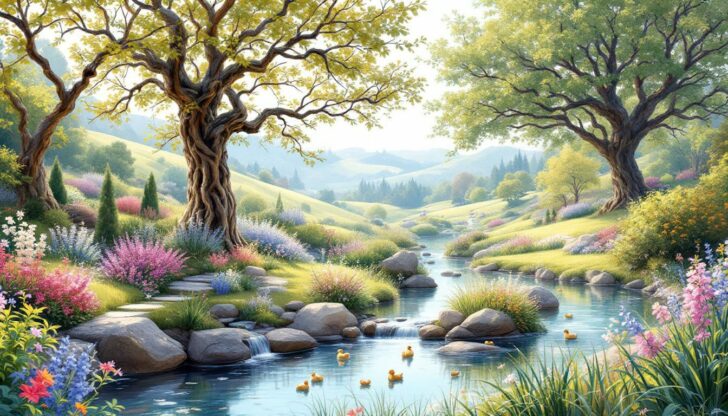
Effective planting techniques bring landscape designs to life, enhancing visual appeal and functionality. Whether using evergreen shrubs and native grasses, creating vibrant flower beds, or establishing raised herb gardens, selecting the right plants and methods is key.
Evergreen Shrubs and Native Grasses
Evergreen shrubs and native grasses are ideal for creating low-maintenance landscapes that thrive year-round. Clumping grasses and evergreen shrubs add structure and visual interest with minimal upkeep.
Native plants, with their colorful, bushy shapes, attract local wildlife and promote biodiversity, making them a sustainable choice for any garden.
Flower Beds and Colorful Flowers
Flower beds with colorful, seasonal blooms can turn any garden into a lively space. Vibrant flowers enhance visual appeal and create a sense of movement throughout the seasons.
Planting cool-season flowers in spring and regularly deadheading blooms can ensure a continuous display of color and beauty.
Raised Beds and Herb Gardens
Raised beds offer easy access and improved soil conditions, making them practical for gardening. Constructed from materials like wood, stainless steel, or corten steel, they are ideal for growing various plants, including herbs like rosemary and sage.
The trend of incorporating edible elements in landscaping reflects a growing interest in sustainable and functional garden spaces.
Creating Functional Outdoor Spaces
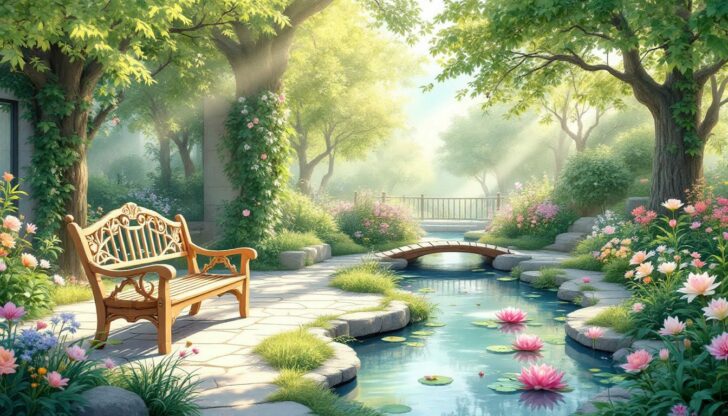
Functional outdoor spaces extend your living area, offering spots for relaxation, socialization, and dining. Consider your family’s lifestyle and add elements like seating areas, outdoor kitchens, and water features to create a beautiful and practical backyard.
Seating Areas and Fire Pits
Seating areas around a fire pit create a cozy environment for social gatherings. Wood-burning metal fire dishes serve as focal points, while ambient lighting and comfortable cushions enhance the atmosphere.
Incorporating plants and natural materials can further create a serene and relaxing space.
Outdoor Kitchens and Dining Spaces
Outdoor kitchens boost your yard’s functionality, making it ideal for entertaining. Features like built-in grills, ample countertop space, and storage ensure a seamless cooking experience.
Creating a defined dining area with weather-resistant furniture and ambient lighting can make outdoor meals a delightful experience.
Water Features and Pools
Water features and pools enhance the aesthetic appeal and recreational value of your yard. Pools with colorful tiles and unique water features, or simple fountains, enrich the overall landscape. Durable materials like concrete and fiberglass ensure longevity, while diving boards or small waterfalls add enjoyment.
Maximizing Small Yard Designs
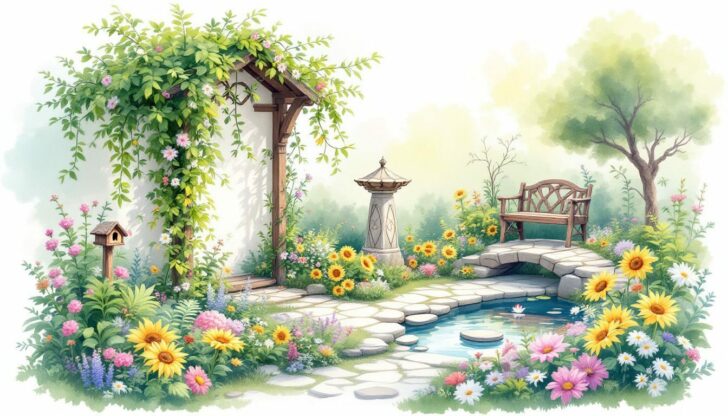
Maximize space in small yards requires creative design solutions. Strategies like vertical gardening, compact patios, and multi-level landscaping can turn limited spaces into functional and visually appealing areas.
Vertical Gardening and Trellises
Vertical gardening utilizes structures to grow plants upward, saving ground space. This method is ideal for urban environments where space is limited but the desire for greenery remains strong.
Trellises and other vertical structures can support a variety of plants, adding height and interest to your garden.
Compact Patio and Deck Ideas
Compact patios and decks create inviting outdoor spaces even in small yards. Using materials like gravel, pavers, and concrete, you can easily build a functional patio.
Movable container gardens offer versatility, allowing you to change the design as needed, while ground covers like creeping thyme enhance the space between pavers.
Multi-Level Landscaping
Multi-level landscaping adds depth and interest to small yards. Inspiring landscaping ideas like terraced gardens create visually appealing layers and improve drainage.
Split-level designs can define distinct areas within compact spaces, making them more dynamic and functional.
Enhancing Your Front Yard
Enhancing your front yard creates curb appeal and makes a great first impression. Incorporate pathways, entryway plantings, and decorative fencing to boost the attractiveness and functionality of your front yard.
Pathways and Driveways
Pathways and driveways guide guests naturally to your front door. Materials like flagstone or brick create intuitive and aesthetically pleasing pathways.
Designing these elements with straight lines and clear directions can enhance the overall flow and appeal of your yard.
Entryway Plantings
Entryway plantings, such as flowering shrubs and small trees, soften the hard lines of your entryway and create a welcoming atmosphere. Plants like hydrangeas, azaleas, and ornamental cherries add seasonal interest and structure.
A harmonious combination of these elements can provide a lush and inviting entryway that enhances curb appeal.
Decorative Fencing and Gates
Decorative fencing and gates define your front yard boundaries while adding style. Open air fences provide structure without obstructing views, and climbing roses or vines over a curved arbor enhance aesthetic appeal.
Adding small vining plants or upright potted plants in front of a privacy fence can further beautify the space.
Seasonal Landscaping Ideas
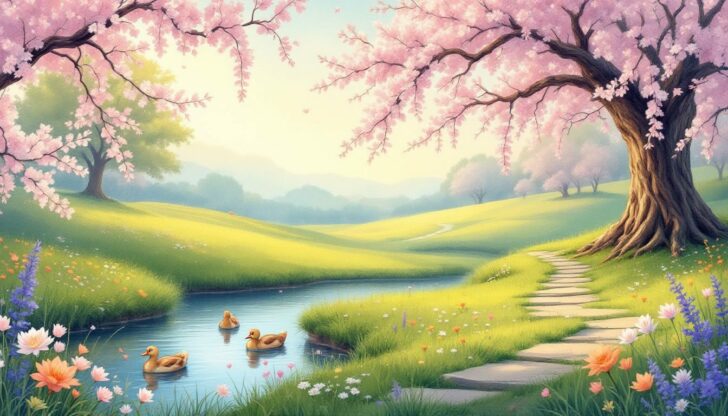
Seasonal landscaping keeps your yard attractive and vibrant year-round. Incorporating plants that bloom in different seasons maintains a dynamic and appealing landscape.
Spring and Summer Blooms
Spring and summer blooms bring color and life to your garden. Planting spring-flowering bulbs in the fall prepares your garden for vibrant colors in spring.
Maintaining these blooms through regular care ensures a lively and beautiful outdoor space during the warmer months.
Fall Foliage and Winter Interest
As summer fades, fall foliage adds a rich and warm palette to your landscape. Plants like oakleaf hydrangeas, ninebark, and spirea are excellent for autumn interest.
In winter, large weeping evergreens, variegated yucca, and ornamental grasses can provide structure and texture. Enhancing your winter landscape with decorative elements like benches and tree sculptures can create a beautiful and inviting scene even in the colder months.
Sustainable Landscaping Practices
Sustainable landscaping practices create eco-friendly and low-maintenance outdoor spaces. Incorporating native plants, composting, and rain gardens reduces environmental impact while maintaining a beautiful yard.
Native Plants and Xeriscaping
Native plants and xeriscaping techniques help conserve water and create sustainable landscapes. Native plants adapt to local conditions and require less maintenance, while xeriscaping minimizes water use.
In desert areas, arranging plants with more space between them can enhance the landscape’s aesthetics and sustainability.
Composting and Mulching
Composting and mulching improve soil health and reduce waste. Compost enriches the soil, enhances drainage, and retains moisture, promoting healthy plant growth.
Mulching with compost helps control weeds, regulate soil temperature, and conserve moisture, creating a healthier and more resilient garden.
Rain Gardens and Permeable Surfaces
Rain gardens and permeable surfaces manage stormwater runoff and protect local waterways. Rain gardens capture and filter rainwater, allowing it to infiltrate the ground and reduce flooding. Permeable paving materials like gravel or porous concrete let water seep through, promoting groundwater recharge.
Combining these elements can significantly enhance stormwater management in your landscape.
Checkout the 50 Beautiful Backyard Landscaping Ideas.
Summary
Transforming your yard with thoughtful landscape design can enhance both its beauty and functionality. By exploring different styles, employing effective planting techniques, creating functional outdoor spaces, and adopting sustainable practices, you can create a unique and inviting outdoor environment. Embrace these inspiring landscaping ideas to turn your yard into a personal haven that reflects your style and needs.
Frequently Asked Questions
What is the modern farmhouse style in landscaping?
The modern farmhouse style in landscaping combines rustic charm with contemporary elements, emphasizing clean lines, neutral tones, and natural materials such as whitewashed brick and large concrete pavers. This cohesive design creates a warm and welcoming outdoor space.
How can I create a low-maintenance garden?
To create a low-maintenance garden, incorporate evergreen shrubs and native grasses, along with drought-tolerant plants, as they require minimal upkeep. This approach will significantly reduce your gardening workload while enhancing the landscape.
What are some design ideas for small yards?
To maximize space in small yards, consider vertical gardening, portable container gardens, and multi-level landscaping. These techniques can create a more functional and aesthetically pleasing outdoor area.
How can I enhance my front yard’s curb appeal?
To enhance your front yard’s curb appeal, consider adding pathways, flowering shrubs, small trees, and decorative fencing. These elements create a welcoming atmosphere and improve the visual appeal of your home.
What are sustainable landscaping practices?
Sustainable landscaping practices focus on using native plants, implementing xeriscaping for water conservation, and improving soil health through composting and mulching. These methods also include creating rain gardens and permeable surfaces to effectively manage stormwater runoff.






